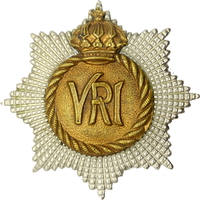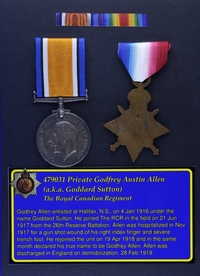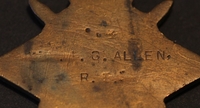
479031 Private Geoffrey Austin Allen
(a.k.a. Goddard Sutton)
The Royal Canadian Regiment
By: Capt (ret'd) Michael M. O'Leary, CD, The RCR
Geoffrey Austin Allen was born at Cardiff, South Wales, on 14 Jul 1897. By 1916 he was residing in St John but it was at Halifax, N.S., that he attested for service in the Canadian Expeditionary Force on 4 Jan 1916 under the assumed name Goddard Sutton. Enlisting as a reinforcement for The Royal Canadian Regiment, Allen is described on his attestation paper as 20 years of age, 5-feet 7 1/4 inches in height, with a medium complexion, hazel eyes and brown hair. His parents were George and Sarah Sutton of 56 Robert St., Cardiff, South Wales, Great Britain.
Allen was one of the soldiers in the Regiment’s 5th Reinforcing Draft, whish sailed from Halifax aboard the S.S. Metagama on 25 Mar 1917. The ship arrived in England at Liverpool on 7 Apr 1917, where Allen was taken on the strength of the 26th Reserve Battalion at Bramshott and entered the Segregation Camp for a quarantine period.
On 21 Jun 1917, his segregation period complete, Allen was struck off the strength of the 26th Reserve Battalion on proceeding overseas to The RCR. That same day he was taken on the strength of The RCR and also crossed the Channel to France. He did not, however, proceed immediately to join the Regiment in the field, but was employed with the 3rd Entrenching Battalion from 13 to 31 Aug 1917. After leaving the 3rd Entr. Bn. for the 3rd Canadian Division Training Centre, it was almost another two weeks before Allen joined The RCR in the field at Le Pendu Camp on 13 Sep 1917.
In mid-September 1917, The RCR was in Divisional Reserve, and conducting daily training programs for the companies and working parties by night. Although the month’s War Diary annexes are not specific, newly joined men like Allen probably also were spending some time of the parade square being brought up to regimental standards for basic soldier dill and duties. The Regiment would Leave Le Pendu Camp and move back into the front lines for a tour from 19 to 24 September, followed by tour in local support trenches and brigade reserve then a further front line tour from 1 to 5 Oct 1917.
Throughout the remainder of October 1917, The RCR conducted training until 22 Oct and then providing carrying and work parties for the Artillery, stretcher parties and other work parties until 28 Oct. On the 29 Oct 1917, the Regiment was in action during the Battle of Passchendaele Ridges until rotating out of the line once again on 4 Nov.
After another week of training, Allen’s next return to the front lines was the return to the Passchendale front for 13-17 Nov 1917. Allen, however, would not complete this tour, being wounded in action on 15 Nov 1917. Two days later, he would be admitted to the 149 Field Ambulance suffering from a “shot wound” of the finger. Shot wound was a generic description for a wound caused by a high velocity projectile, shrapnel often being the cause.
Allen’s wound was serious enough, probably combined with the numbers of casualties being received across the CEF medical system, to require rearward evacuation. On 18 Nov 1917 he was transferred and admitted to No. 64 Casualty Clearing Station. He moved again on the following day, 19 Nov 1917, and was admitted to 54 (London) General Hospital at Aubengue, France, near Boulogne-sur-Mer.
Allen remained at Aubenge until 7 Dec, when his file also reveals that his medical problems were not limited to his wounded finger. While in hospital in France, he “was given 500 units Anti-Tetanus Serum (A.T.S.) between 17 Nov and 8 Dec 1917.” On 7 Dec 1917 he was invalided and posted to Nova Scotia Regimental Depot (N.S.R.D.), Bramshott, on being evacuated to England aboard the hospital ship H.S. Jan Breydel. On disembarking, he was admitted to 1st Southern General Hospital, Stoursbridge Section, with “S.W. finger” and “Trench feet (severe).”
On Christmas Day, 1917, Allen would be transferred to the Canadian Convalescent Hospital Bearwood (Wokingham), where he would remain until New Year’s Day when he would report to the N.S.R.D. He would remain on the strength of the Depot until returning to France on 19 Apr 1918. While in England he would spend a few weeks On Command with the 2nd Canadian Command Depot. On his way back to The RCR in France, Allen would pass through the 11th and 17th Reserve Battalions, the Canadian Infantry Base Depot, and the Canadian Corps Reinforcement Camp, finally rejoining The RCR in the field on 24 Apr 1918.
Shortly after his return to regimental duty, Allen decided that it was time to divest himself of his assumed name. Accordingly, on 29 Apr 1918, the Regiment’s Daily Orders, part II, read: “479031 Pte G. SUTTON; Having declared his true name to be GODFREY AUSTIN ALLEN will in future be known as such. All documents to be changed accordingly.”
Allen would remain with the Regiment in the field for the remainder of the War, surviving the battles of the summer and fall of 1918. On 5 Feb 1919, he would ne struck off the strength of the Canadian Concentration Camp at Le Havre, for demobilization from the Canadian Forces Overseas and proceed to England the next day.
The final entries in his service record show Allen to be struck off strength of The RCR having been discharged in the British Isles under KR&O Para 392 Sect XXV and Discharges Board (Demob C.R.O. 5222) on 28 Feb 1919. He was discharged at the 2nd Canadian Discharge Depot, London, the same day. His intended place of residence was his parents' home at 56 Robert St., Cardiff, South Wales, G.B.
A Curiosity and a Possible Explanation
Geoffrey Allen's British War Medal was accompanied by a curiosity. This second item was a 1914-15 Star, a medal to which Allen was not entitled, which had been altered to leave naming details which matched Allen's own, although incomplete. On close examination, the Star appears to be the medal of a Royal Engineer Sapper with a second initial "G" and the same surname; details which did not match Allen's own had been removed by scratching them out. It is likely that Allen desired to represent himself as having longer service than he actually did, and claimed an earler date of arrival in France through the wearing of the 1914-15 Star.
Pro Patria
Visit a randomly selected page in The O'Leary Collection (or reload for another choice):
- The O'Leary Collection; Medals of The Royal Canadian Regiment.
- Researching Canadian Soldiers of the First World War
- Researching The Royal Canadian Regiment
- The RCR in the First World War
- Badges of The RCR
- The Senior Subaltern
- The Minute Book (blog)
- Rogue Papers
- Tactical Primers
- The Regimental Library
- Battle Honours
- Perpetuation of the CEF
- A Miscellany
- Quotes
- The Frontenac Times
- Site Map
QUICK LINKS
The O'Leary Collection—Medals of The Royal Canadian Regiment
Newest additions:
![]()
![]() SB-12725 Private Henry "Hank" Ard
SB-12725 Private Henry "Hank" Ard ![]()
WIA at Hill 187, Died of Wounds in Japan
![]()
![]() 2355331 Lance Corporal Albert Lorking
2355331 Lance Corporal Albert Lorking
Wounded in action, later a War Amps representative.
![]()
![]() 4334 / 477996 Pte Isaac Hamilton Wilcox
4334 / 477996 Pte Isaac Hamilton Wilcox
Permanent Force, South Africa, and C.E.F.
![]()
![]() 477019 Private Harold Ashcroft
477019 Private Harold Ashcroft
Transferred to the Tunnelers.
![]()
![]() 734231 Private Clark D. Thompson
734231 Private Clark D. Thompson ![]()
The older Thompson brother, killed in action.
![]()
![]() 733849 Private Norman Parker Thompson
733849 Private Norman Parker Thompson
The younger Thompson brother; post-war service in the Special Guard.
![]()
![]()
![]() A305 / 400305 Private Andrew Walker
A305 / 400305 Private Andrew Walker ![]()
"Previously reported Wounded, now Killed in Action."
![]()
![]() 823298 Pte Thomas Patrick Steele, M.M.
823298 Pte Thomas Patrick Steele, M.M. ![]()
… for gallant conduct in the field …
![]()
![]() P13066 Sergeant Harold Thompson
P13066 Sergeant Harold Thompson
Instrumental Soloist for over 20 years of Canadian Army service.
![]()
![]() 9609 / 477728 Private Albert Edward Piper
9609 / 477728 Private Albert Edward Piper
"Arrived from England as a STOWAWAY …"




